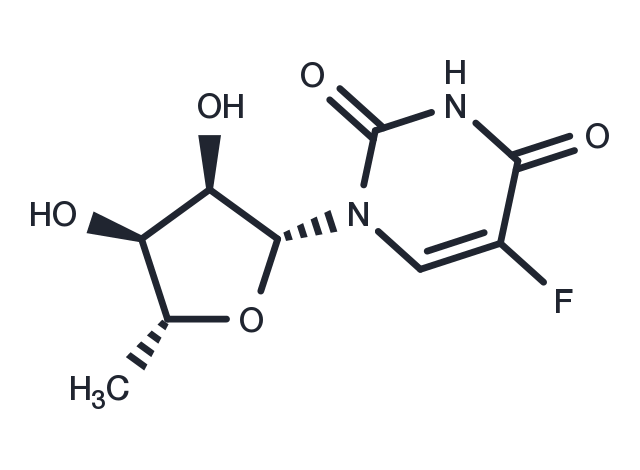Powder: -20°C for 3 years | In solvent: -80°C for 1 year


Doxifluridine (AMC 0101) is a fluoropyrimidine derivative and oral prodrug of the antineoplastic agent 5-fluorouracil (5-FU) with antitumor activity. Doxifluridine, designed to circumvent the rapid degradation of 5-FU by dihydropyrimidine dehydrogenase in the gut wall, is converted into 5-FU in the presence of pyrimidine nucleoside phosphorylase. 5-FU interferes with DNA synthesis and subsequent cell division by reducing normal thymidine production and interferes with RNA transcription by competing with uridine triphosphate for incorporation into the RNA strand.

| Pack Size | Availability | Price/USD | Quantity |
|---|---|---|---|
| 500 mg | In stock | $ 45.00 | |
| 1 g | In stock | $ 67.00 |





| Description | Doxifluridine (AMC 0101) is a fluoropyrimidine derivative and oral prodrug of the antineoplastic agent 5-fluorouracil (5-FU) with antitumor activity. Doxifluridine, designed to circumvent the rapid degradation of 5-FU by dihydropyrimidine dehydrogenase in the gut wall, is converted into 5-FU in the presence of pyrimidine nucleoside phosphorylase. 5-FU interferes with DNA synthesis and subsequent cell division by reducing normal thymidine production and interferes with RNA transcription by competing with uridine triphosphate for incorporation into the RNA strand. |
| In vitro | Doxifluridine suppresses tube formation of HUVEC and vascular endothelial growth factor production by FU-MMT-1 cells. [1] Doxifluridine is converted to 5-FU and subsequently to FdUMP, and the results suggest that Doxifluridine exerts its cytotoxic effects through inhibition of TS and incorporation into RNA. [2] Doxifluridine is a fluoropyrimidine derivative that is activated preferentially in malignant cells by thymidine phosphorylase to form 5-fluorouracil (5-FU). Doxifluridine is developed to improve the therapeutic index of 5-FU and to reduce toxicity, including the immunosuppressive, myelosuppressive, and cardiotoxic effects of 5-FU and other fluorinated pyrimidines. [3] |
| In vivo | Metronomic Doxifluridine alone significantly suppresses tumor growth compared with the untreated (control) group, while metronomic Doxifluridine in combination with TNP-470 significantly inhibits tumor growth compared with each treatment alone in in FU-MMT-1 xenografts. Doxifluridine in combination with TNP-470 also leads to a significant reduction of intratumoral vascularity. [1] Doxifluridine significantly inhibits the growth of KPL-4 tumors, reduces the tissue levels of IL-6, and alleviates body weight loss in nude mice bearing KPL-4 tumors. [4] Doxifluridine results in a significant reduction in the activity of phenytoin p-hydroxylation in rats. Doxifluridine decreases the elimination rate constant and the total clearance in rats. [5] |
| Synonyms | Ro 21-9738, AMC 0101, 5'-DFUR, 5-Fluoro-5'-deoxyuridine |
| Molecular Weight | 246.19 |
| Formula | C9H11FN2O5 |
| CAS No. | 3094-09-5 |
Powder: -20°C for 3 years | In solvent: -80°C for 1 year
Ethanol: < 1 mg/mL (insoluble or slightly soluble)
H2O: 45 mg/mL (182.8 mM)
DMSO: 46 mg/mL (186.8 mM)
You can also refer to dose conversion for different animals. More
bottom
Please see Inhibitor Handling Instructions for more frequently ask questions. Topics include: how to prepare stock solutions, how to store products, and cautions on cell-based assays & animal experiments, etc.
Doxifluridine 3094-09-5 Cell Cycle/Checkpoint DNA Damage/DNA Repair Nucleoside Antimetabolite/Analog DNA/RNA Synthesis Ro 21-9738 Inhibitor AMC 0101 5'-DFUR AMC-0101 5-Fluoro-5'-deoxyuridine AMC0101 inhibit inhibitor
